Med-Arb in Australia: Advantages, Disadvantages, Alternatives
VerifiedAdded on 2022/11/25
|11
|2779
|409
Essay
AI Summary
This research essay offers a comprehensive analysis of Med-Arb (Mediation-Arbitration) in the Australian context. It examines the process, which combines mediation and arbitration for resolving legal issues outside of court, exploring its advantages, such as efficiency and momentum, and disadvanta...

Mediation & Arbitration
Australia
Australia
Secure Best Marks with AI Grader
Need help grading? Try our AI Grader for instant feedback on your assignments.
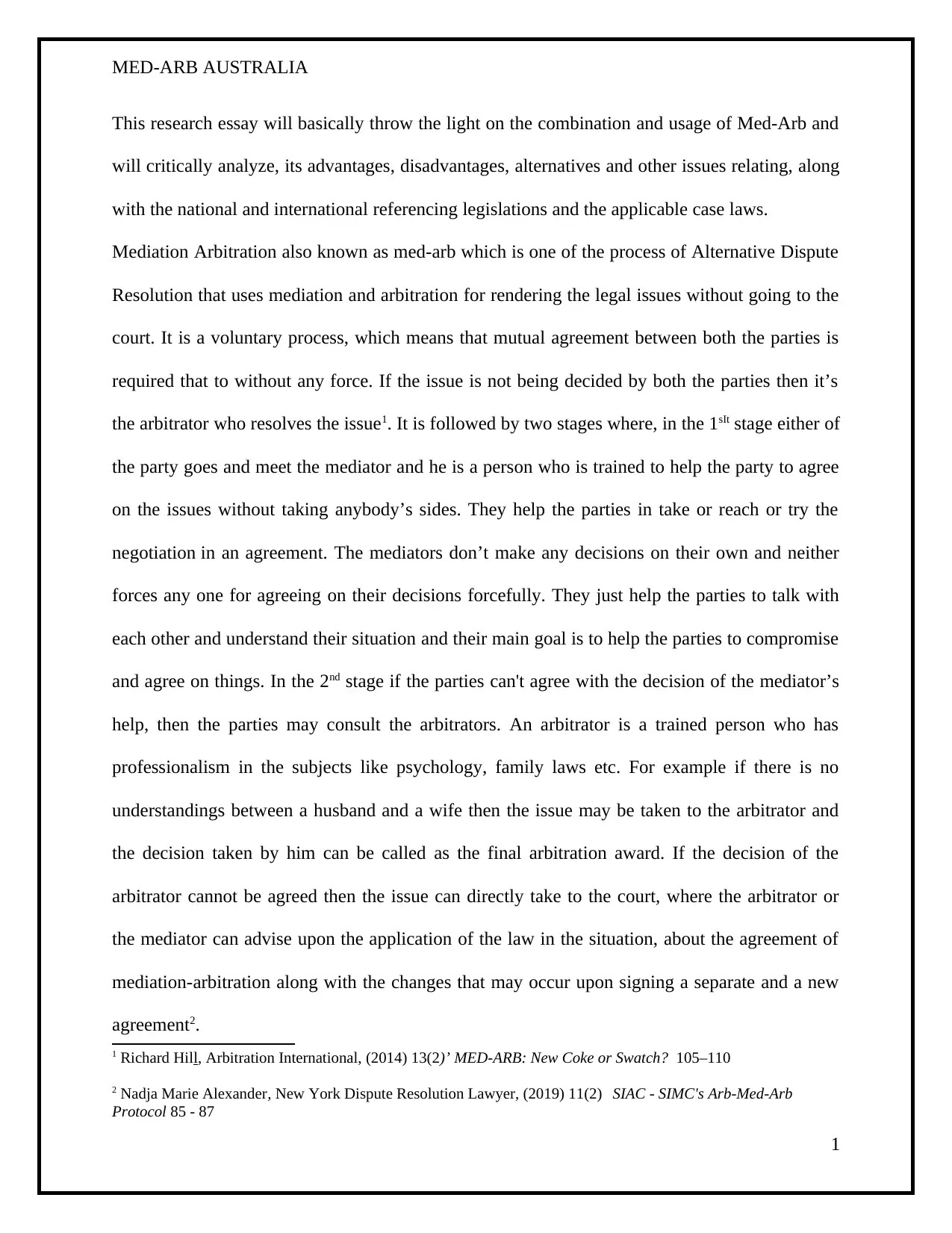
MED-ARB AUSTRALIA
This research essay will basically throw the light on the combination and usage of Med-Arb and
will critically analyze, its advantages, disadvantages, alternatives and other issues relating, along
with the national and international referencing legislations and the applicable case laws.
Mediation Arbitration also known as med-arb which is one of the process of Alternative Dispute
Resolution that uses mediation and arbitration for rendering the legal issues without going to the
court. It is a voluntary process, which means that mutual agreement between both the parties is
required that to without any force. If the issue is not being decided by both the parties then it’s
the arbitrator who resolves the issue1. It is followed by two stages where, in the 1sIt stage either of
the party goes and meet the mediator and he is a person who is trained to help the party to agree
on the issues without taking anybody’s sides. They help the parties in take or reach or try the
negotiation in an agreement. The mediators don’t make any decisions on their own and neither
forces any one for agreeing on their decisions forcefully. They just help the parties to talk with
each other and understand their situation and their main goal is to help the parties to compromise
and agree on things. In the 2nd stage if the parties can't agree with the decision of the mediator’s
help, then the parties may consult the arbitrators. An arbitrator is a trained person who has
professionalism in the subjects like psychology, family laws etc. For example if there is no
understandings between a husband and a wife then the issue may be taken to the arbitrator and
the decision taken by him can be called as the final arbitration award. If the decision of the
arbitrator cannot be agreed then the issue can directly take to the court, where the arbitrator or
the mediator can advise upon the application of the law in the situation, about the agreement of
mediation-arbitration along with the changes that may occur upon signing a separate and a new
agreement2.
1 Richard Hill, Arbitration International, (2014) 13(2)’ MED-ARB: New Coke or Swatch? 105–110
2 Nadja Marie Alexander, New York Dispute Resolution Lawyer, (2019) 11(2) SIAC - SIMC's Arb-Med-Arb
Protocol 85 - 87
1
This research essay will basically throw the light on the combination and usage of Med-Arb and
will critically analyze, its advantages, disadvantages, alternatives and other issues relating, along
with the national and international referencing legislations and the applicable case laws.
Mediation Arbitration also known as med-arb which is one of the process of Alternative Dispute
Resolution that uses mediation and arbitration for rendering the legal issues without going to the
court. It is a voluntary process, which means that mutual agreement between both the parties is
required that to without any force. If the issue is not being decided by both the parties then it’s
the arbitrator who resolves the issue1. It is followed by two stages where, in the 1sIt stage either of
the party goes and meet the mediator and he is a person who is trained to help the party to agree
on the issues without taking anybody’s sides. They help the parties in take or reach or try the
negotiation in an agreement. The mediators don’t make any decisions on their own and neither
forces any one for agreeing on their decisions forcefully. They just help the parties to talk with
each other and understand their situation and their main goal is to help the parties to compromise
and agree on things. In the 2nd stage if the parties can't agree with the decision of the mediator’s
help, then the parties may consult the arbitrators. An arbitrator is a trained person who has
professionalism in the subjects like psychology, family laws etc. For example if there is no
understandings between a husband and a wife then the issue may be taken to the arbitrator and
the decision taken by him can be called as the final arbitration award. If the decision of the
arbitrator cannot be agreed then the issue can directly take to the court, where the arbitrator or
the mediator can advise upon the application of the law in the situation, about the agreement of
mediation-arbitration along with the changes that may occur upon signing a separate and a new
agreement2.
1 Richard Hill, Arbitration International, (2014) 13(2)’ MED-ARB: New Coke or Swatch? 105–110
2 Nadja Marie Alexander, New York Dispute Resolution Lawyer, (2019) 11(2) SIAC - SIMC's Arb-Med-Arb
Protocol 85 - 87
1
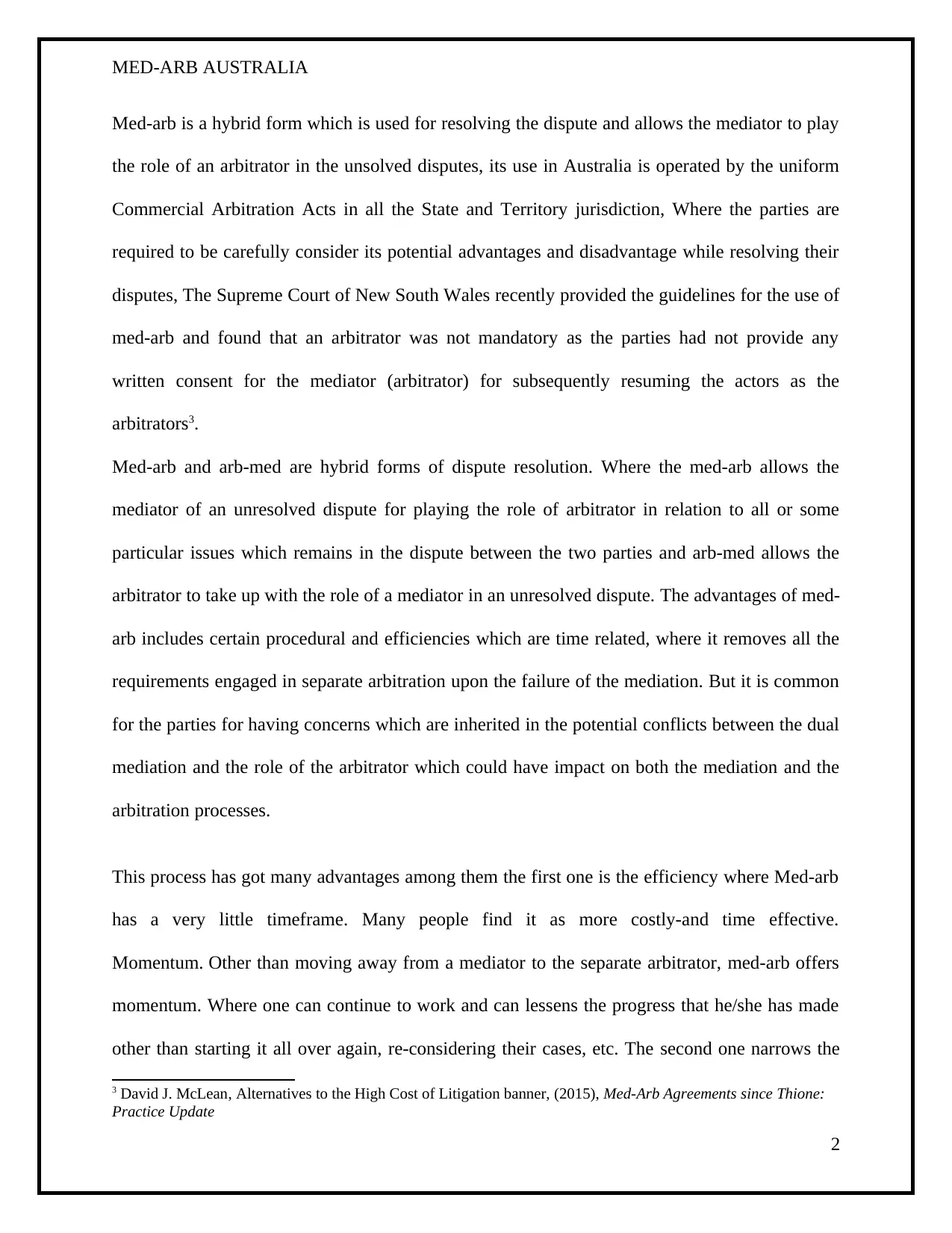
MED-ARB AUSTRALIA
Med-arb is a hybrid form which is used for resolving the dispute and allows the mediator to play
the role of an arbitrator in the unsolved disputes, its use in Australia is operated by the uniform
Commercial Arbitration Acts in all the State and Territory jurisdiction, Where the parties are
required to be carefully consider its potential advantages and disadvantage while resolving their
disputes, The Supreme Court of New South Wales recently provided the guidelines for the use of
med-arb and found that an arbitrator was not mandatory as the parties had not provide any
written consent for the mediator (arbitrator) for subsequently resuming the actors as the
arbitrators3.
Med-arb and arb-med are hybrid forms of dispute resolution. Where the med-arb allows the
mediator of an unresolved dispute for playing the role of arbitrator in relation to all or some
particular issues which remains in the dispute between the two parties and arb-med allows the
arbitrator to take up with the role of a mediator in an unresolved dispute. The advantages of med-
arb includes certain procedural and efficiencies which are time related, where it removes all the
requirements engaged in separate arbitration upon the failure of the mediation. But it is common
for the parties for having concerns which are inherited in the potential conflicts between the dual
mediation and the role of the arbitrator which could have impact on both the mediation and the
arbitration processes.
This process has got many advantages among them the first one is the efficiency where Med-arb
has a very little timeframe. Many people find it as more costly-and time effective.
Momentum. Other than moving away from a mediator to the separate arbitrator, med-arb offers
momentum. Where one can continue to work and can lessens the progress that he/she has made
other than starting it all over again, re-considering their cases, etc. The second one narrows the
3 David J. McLean, Alternatives to the High Cost of Litigation banner, (2015), Med-Arb Agreements since Thione:
Practice Update
2
Med-arb is a hybrid form which is used for resolving the dispute and allows the mediator to play
the role of an arbitrator in the unsolved disputes, its use in Australia is operated by the uniform
Commercial Arbitration Acts in all the State and Territory jurisdiction, Where the parties are
required to be carefully consider its potential advantages and disadvantage while resolving their
disputes, The Supreme Court of New South Wales recently provided the guidelines for the use of
med-arb and found that an arbitrator was not mandatory as the parties had not provide any
written consent for the mediator (arbitrator) for subsequently resuming the actors as the
arbitrators3.
Med-arb and arb-med are hybrid forms of dispute resolution. Where the med-arb allows the
mediator of an unresolved dispute for playing the role of arbitrator in relation to all or some
particular issues which remains in the dispute between the two parties and arb-med allows the
arbitrator to take up with the role of a mediator in an unresolved dispute. The advantages of med-
arb includes certain procedural and efficiencies which are time related, where it removes all the
requirements engaged in separate arbitration upon the failure of the mediation. But it is common
for the parties for having concerns which are inherited in the potential conflicts between the dual
mediation and the role of the arbitrator which could have impact on both the mediation and the
arbitration processes.
This process has got many advantages among them the first one is the efficiency where Med-arb
has a very little timeframe. Many people find it as more costly-and time effective.
Momentum. Other than moving away from a mediator to the separate arbitrator, med-arb offers
momentum. Where one can continue to work and can lessens the progress that he/she has made
other than starting it all over again, re-considering their cases, etc. The second one narrows the
3 David J. McLean, Alternatives to the High Cost of Litigation banner, (2015), Med-Arb Agreements since Thione:
Practice Update
2
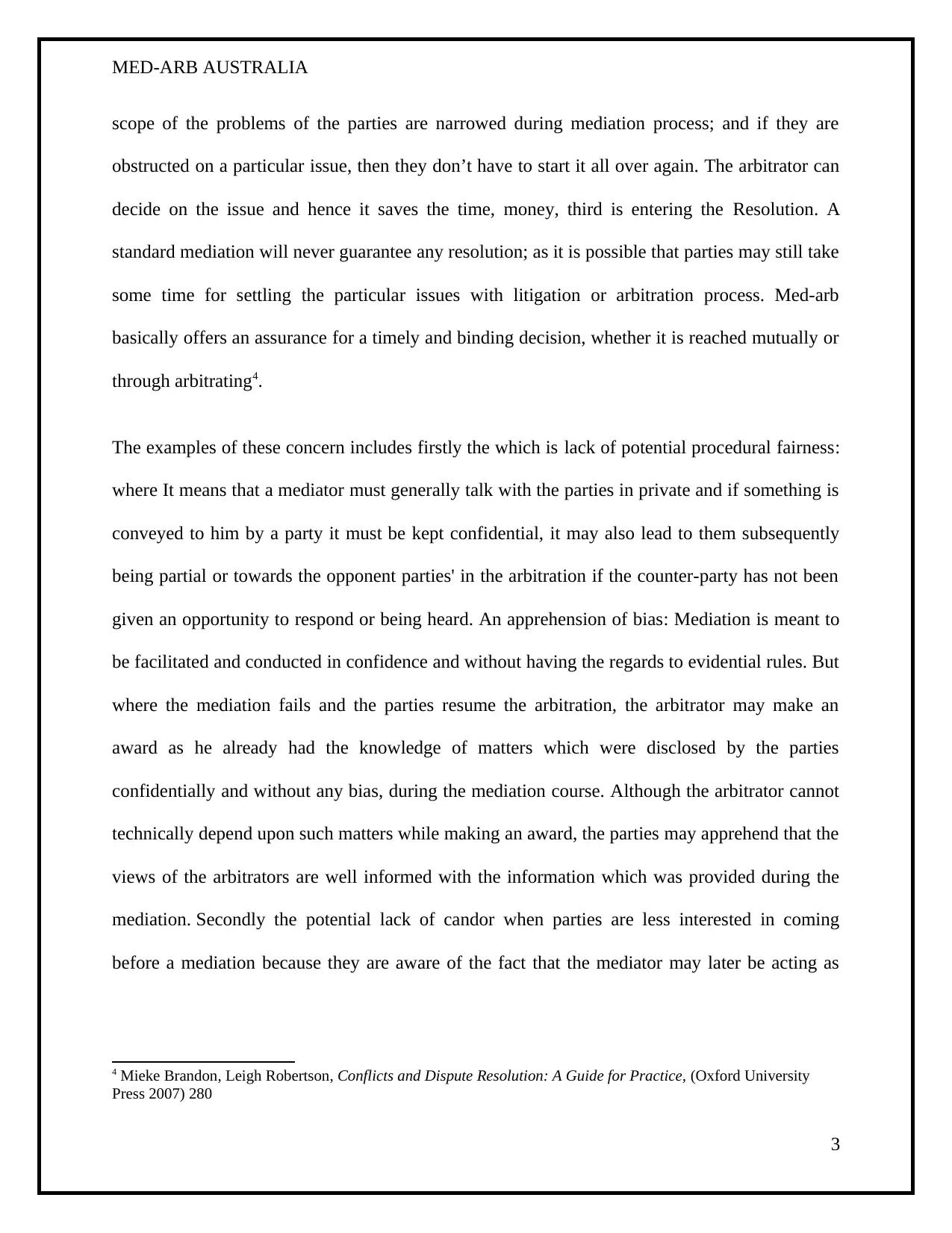
MED-ARB AUSTRALIA
scope of the problems of the parties are narrowed during mediation process; and if they are
obstructed on a particular issue, then they don’t have to start it all over again. The arbitrator can
decide on the issue and hence it saves the time, money, third is entering the Resolution. A
standard mediation will never guarantee any resolution; as it is possible that parties may still take
some time for settling the particular issues with litigation or arbitration process. Med-arb
basically offers an assurance for a timely and binding decision, whether it is reached mutually or
through arbitrating4.
The examples of these concern includes firstly the which is lack of potential procedural fairness:
where It means that a mediator must generally talk with the parties in private and if something is
conveyed to him by a party it must be kept confidential, it may also lead to them subsequently
being partial or towards the opponent parties' in the arbitration if the counter-party has not been
given an opportunity to respond or being heard. An apprehension of bias: Mediation is meant to
be facilitated and conducted in confidence and without having the regards to evidential rules. But
where the mediation fails and the parties resume the arbitration, the arbitrator may make an
award as he already had the knowledge of matters which were disclosed by the parties
confidentially and without any bias, during the mediation course. Although the arbitrator cannot
technically depend upon such matters while making an award, the parties may apprehend that the
views of the arbitrators are well informed with the information which was provided during the
mediation. Secondly the potential lack of candor when parties are less interested in coming
before a mediation because they are aware of the fact that the mediator may later be acting as
4 Mieke Brandon, Leigh Robertson, Conflicts and Dispute Resolution: A Guide for Practice, (Oxford University
Press 2007) 280
3
scope of the problems of the parties are narrowed during mediation process; and if they are
obstructed on a particular issue, then they don’t have to start it all over again. The arbitrator can
decide on the issue and hence it saves the time, money, third is entering the Resolution. A
standard mediation will never guarantee any resolution; as it is possible that parties may still take
some time for settling the particular issues with litigation or arbitration process. Med-arb
basically offers an assurance for a timely and binding decision, whether it is reached mutually or
through arbitrating4.
The examples of these concern includes firstly the which is lack of potential procedural fairness:
where It means that a mediator must generally talk with the parties in private and if something is
conveyed to him by a party it must be kept confidential, it may also lead to them subsequently
being partial or towards the opponent parties' in the arbitration if the counter-party has not been
given an opportunity to respond or being heard. An apprehension of bias: Mediation is meant to
be facilitated and conducted in confidence and without having the regards to evidential rules. But
where the mediation fails and the parties resume the arbitration, the arbitrator may make an
award as he already had the knowledge of matters which were disclosed by the parties
confidentially and without any bias, during the mediation course. Although the arbitrator cannot
technically depend upon such matters while making an award, the parties may apprehend that the
views of the arbitrators are well informed with the information which was provided during the
mediation. Secondly the potential lack of candor when parties are less interested in coming
before a mediation because they are aware of the fact that the mediator may later be acting as
4 Mieke Brandon, Leigh Robertson, Conflicts and Dispute Resolution: A Guide for Practice, (Oxford University
Press 2007) 280
3
Secure Best Marks with AI Grader
Need help grading? Try our AI Grader for instant feedback on your assignments.
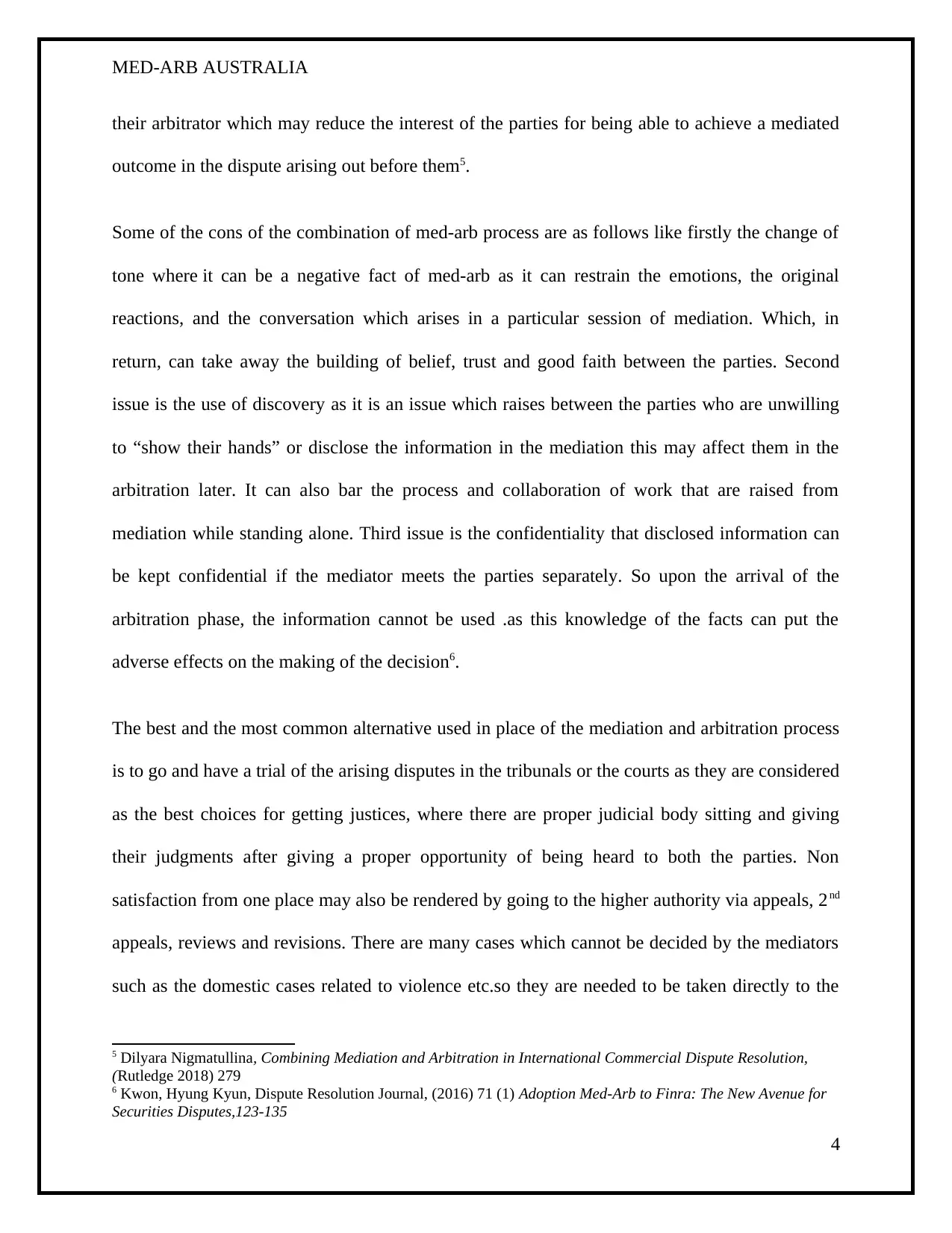
MED-ARB AUSTRALIA
their arbitrator which may reduce the interest of the parties for being able to achieve a mediated
outcome in the dispute arising out before them5.
Some of the cons of the combination of med-arb process are as follows like firstly the change of
tone where it can be a negative fact of med-arb as it can restrain the emotions, the original
reactions, and the conversation which arises in a particular session of mediation. Which, in
return, can take away the building of belief, trust and good faith between the parties. Second
issue is the use of discovery as it is an issue which raises between the parties who are unwilling
to “show their hands” or disclose the information in the mediation this may affect them in the
arbitration later. It can also bar the process and collaboration of work that are raised from
mediation while standing alone. Third issue is the confidentiality that disclosed information can
be kept confidential if the mediator meets the parties separately. So upon the arrival of the
arbitration phase, the information cannot be used .as this knowledge of the facts can put the
adverse effects on the making of the decision6.
The best and the most common alternative used in place of the mediation and arbitration process
is to go and have a trial of the arising disputes in the tribunals or the courts as they are considered
as the best choices for getting justices, where there are proper judicial body sitting and giving
their judgments after giving a proper opportunity of being heard to both the parties. Non
satisfaction from one place may also be rendered by going to the higher authority via appeals, 2nd
appeals, reviews and revisions. There are many cases which cannot be decided by the mediators
such as the domestic cases related to violence etc.so they are needed to be taken directly to the
5 Dilyara Nigmatullina, Combining Mediation and Arbitration in International Commercial Dispute Resolution,
(Rutledge 2018) 279
6 Kwon, Hyung Kyun, Dispute Resolution Journal, (2016) 71 (1) Adoption Med-Arb to Finra: The New Avenue for
Securities Disputes,123-135
4
their arbitrator which may reduce the interest of the parties for being able to achieve a mediated
outcome in the dispute arising out before them5.
Some of the cons of the combination of med-arb process are as follows like firstly the change of
tone where it can be a negative fact of med-arb as it can restrain the emotions, the original
reactions, and the conversation which arises in a particular session of mediation. Which, in
return, can take away the building of belief, trust and good faith between the parties. Second
issue is the use of discovery as it is an issue which raises between the parties who are unwilling
to “show their hands” or disclose the information in the mediation this may affect them in the
arbitration later. It can also bar the process and collaboration of work that are raised from
mediation while standing alone. Third issue is the confidentiality that disclosed information can
be kept confidential if the mediator meets the parties separately. So upon the arrival of the
arbitration phase, the information cannot be used .as this knowledge of the facts can put the
adverse effects on the making of the decision6.
The best and the most common alternative used in place of the mediation and arbitration process
is to go and have a trial of the arising disputes in the tribunals or the courts as they are considered
as the best choices for getting justices, where there are proper judicial body sitting and giving
their judgments after giving a proper opportunity of being heard to both the parties. Non
satisfaction from one place may also be rendered by going to the higher authority via appeals, 2nd
appeals, reviews and revisions. There are many cases which cannot be decided by the mediators
such as the domestic cases related to violence etc.so they are needed to be taken directly to the
5 Dilyara Nigmatullina, Combining Mediation and Arbitration in International Commercial Dispute Resolution,
(Rutledge 2018) 279
6 Kwon, Hyung Kyun, Dispute Resolution Journal, (2016) 71 (1) Adoption Med-Arb to Finra: The New Avenue for
Securities Disputes,123-135
4
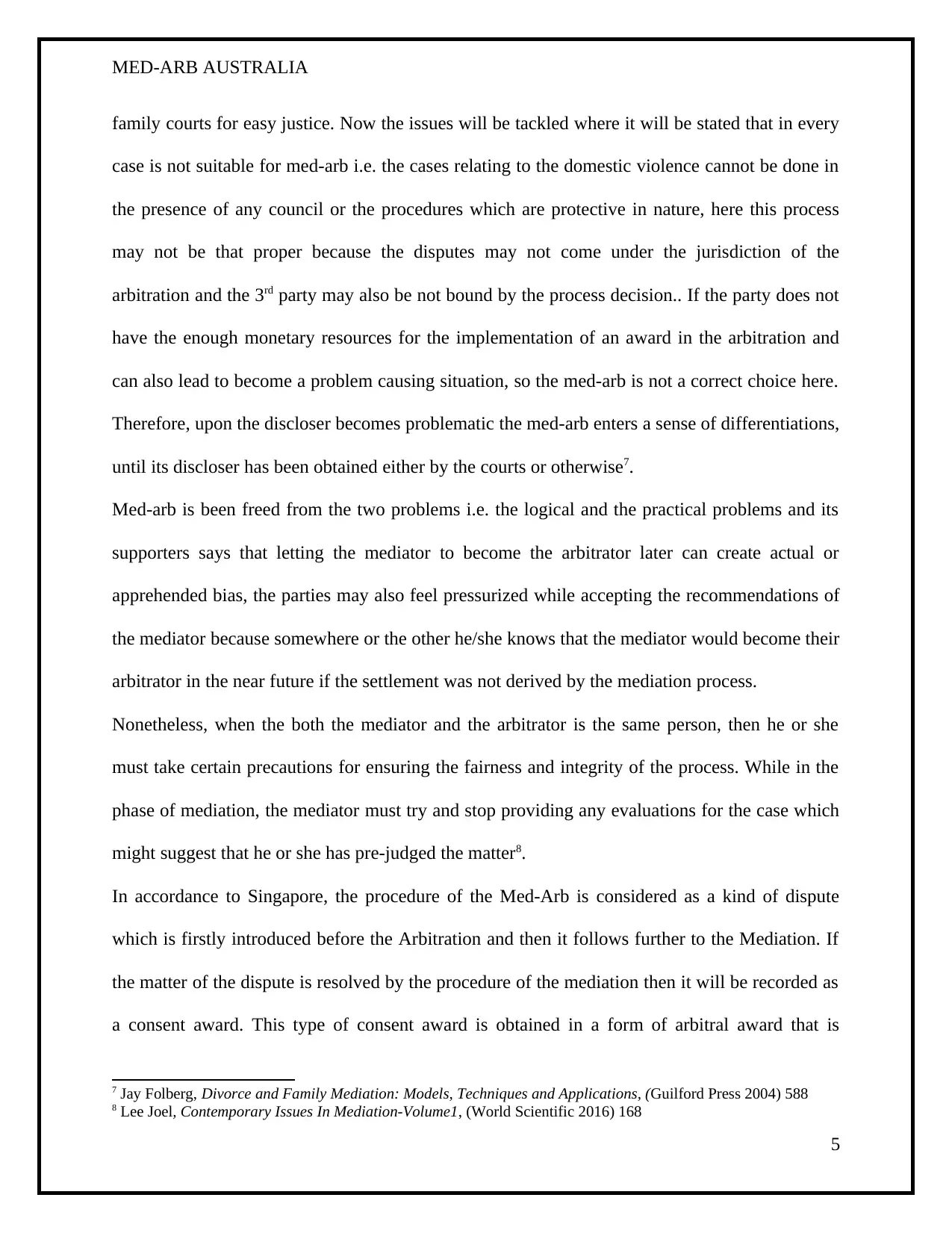
MED-ARB AUSTRALIA
family courts for easy justice. Now the issues will be tackled where it will be stated that in every
case is not suitable for med-arb i.e. the cases relating to the domestic violence cannot be done in
the presence of any council or the procedures which are protective in nature, here this process
may not be that proper because the disputes may not come under the jurisdiction of the
arbitration and the 3rd party may also be not bound by the process decision.. If the party does not
have the enough monetary resources for the implementation of an award in the arbitration and
can also lead to become a problem causing situation, so the med-arb is not a correct choice here.
Therefore, upon the discloser becomes problematic the med-arb enters a sense of differentiations,
until its discloser has been obtained either by the courts or otherwise7.
Med-arb is been freed from the two problems i.e. the logical and the practical problems and its
supporters says that letting the mediator to become the arbitrator later can create actual or
apprehended bias, the parties may also feel pressurized while accepting the recommendations of
the mediator because somewhere or the other he/she knows that the mediator would become their
arbitrator in the near future if the settlement was not derived by the mediation process.
Nonetheless, when the both the mediator and the arbitrator is the same person, then he or she
must take certain precautions for ensuring the fairness and integrity of the process. While in the
phase of mediation, the mediator must try and stop providing any evaluations for the case which
might suggest that he or she has pre-judged the matter8.
In accordance to Singapore, the procedure of the Med-Arb is considered as a kind of dispute
which is firstly introduced before the Arbitration and then it follows further to the Mediation. If
the matter of the dispute is resolved by the procedure of the mediation then it will be recorded as
a consent award. This type of consent award is obtained in a form of arbitral award that is
7 Jay Folberg, Divorce and Family Mediation: Models, Techniques and Applications, (Guilford Press 2004) 588
8 Lee Joel, Contemporary Issues In Mediation-Volume1, (World Scientific 2016) 168
5
family courts for easy justice. Now the issues will be tackled where it will be stated that in every
case is not suitable for med-arb i.e. the cases relating to the domestic violence cannot be done in
the presence of any council or the procedures which are protective in nature, here this process
may not be that proper because the disputes may not come under the jurisdiction of the
arbitration and the 3rd party may also be not bound by the process decision.. If the party does not
have the enough monetary resources for the implementation of an award in the arbitration and
can also lead to become a problem causing situation, so the med-arb is not a correct choice here.
Therefore, upon the discloser becomes problematic the med-arb enters a sense of differentiations,
until its discloser has been obtained either by the courts or otherwise7.
Med-arb is been freed from the two problems i.e. the logical and the practical problems and its
supporters says that letting the mediator to become the arbitrator later can create actual or
apprehended bias, the parties may also feel pressurized while accepting the recommendations of
the mediator because somewhere or the other he/she knows that the mediator would become their
arbitrator in the near future if the settlement was not derived by the mediation process.
Nonetheless, when the both the mediator and the arbitrator is the same person, then he or she
must take certain precautions for ensuring the fairness and integrity of the process. While in the
phase of mediation, the mediator must try and stop providing any evaluations for the case which
might suggest that he or she has pre-judged the matter8.
In accordance to Singapore, the procedure of the Med-Arb is considered as a kind of dispute
which is firstly introduced before the Arbitration and then it follows further to the Mediation. If
the matter of the dispute is resolved by the procedure of the mediation then it will be recorded as
a consent award. This type of consent award is obtained in a form of arbitral award that is
7 Jay Folberg, Divorce and Family Mediation: Models, Techniques and Applications, (Guilford Press 2004) 588
8 Lee Joel, Contemporary Issues In Mediation-Volume1, (World Scientific 2016) 168
5
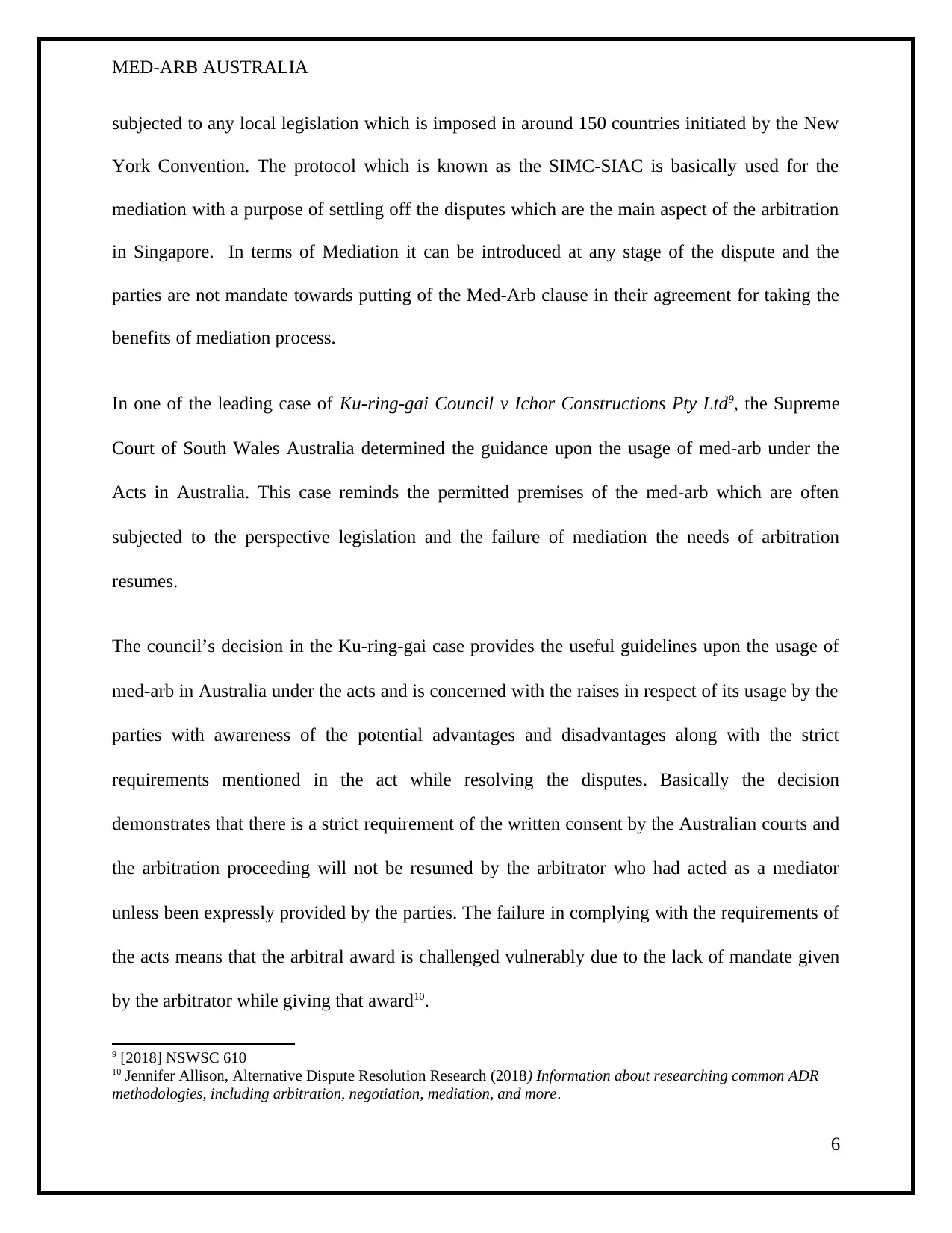
MED-ARB AUSTRALIA
subjected to any local legislation which is imposed in around 150 countries initiated by the New
York Convention. The protocol which is known as the SIMC-SIAC is basically used for the
mediation with a purpose of settling off the disputes which are the main aspect of the arbitration
in Singapore. In terms of Mediation it can be introduced at any stage of the dispute and the
parties are not mandate towards putting of the Med-Arb clause in their agreement for taking the
benefits of mediation process.
In one of the leading case of Ku-ring-gai Council v Ichor Constructions Pty Ltd9, the Supreme
Court of South Wales Australia determined the guidance upon the usage of med-arb under the
Acts in Australia. This case reminds the permitted premises of the med-arb which are often
subjected to the perspective legislation and the failure of mediation the needs of arbitration
resumes.
The council’s decision in the Ku-ring-gai case provides the useful guidelines upon the usage of
med-arb in Australia under the acts and is concerned with the raises in respect of its usage by the
parties with awareness of the potential advantages and disadvantages along with the strict
requirements mentioned in the act while resolving the disputes. Basically the decision
demonstrates that there is a strict requirement of the written consent by the Australian courts and
the arbitration proceeding will not be resumed by the arbitrator who had acted as a mediator
unless been expressly provided by the parties. The failure in complying with the requirements of
the acts means that the arbitral award is challenged vulnerably due to the lack of mandate given
by the arbitrator while giving that award10.
9 [2018] NSWSC 610
10 Jennifer Allison, Alternative Dispute Resolution Research (2018) Information about researching common ADR
methodologies, including arbitration, negotiation, mediation, and more.
6
subjected to any local legislation which is imposed in around 150 countries initiated by the New
York Convention. The protocol which is known as the SIMC-SIAC is basically used for the
mediation with a purpose of settling off the disputes which are the main aspect of the arbitration
in Singapore. In terms of Mediation it can be introduced at any stage of the dispute and the
parties are not mandate towards putting of the Med-Arb clause in their agreement for taking the
benefits of mediation process.
In one of the leading case of Ku-ring-gai Council v Ichor Constructions Pty Ltd9, the Supreme
Court of South Wales Australia determined the guidance upon the usage of med-arb under the
Acts in Australia. This case reminds the permitted premises of the med-arb which are often
subjected to the perspective legislation and the failure of mediation the needs of arbitration
resumes.
The council’s decision in the Ku-ring-gai case provides the useful guidelines upon the usage of
med-arb in Australia under the acts and is concerned with the raises in respect of its usage by the
parties with awareness of the potential advantages and disadvantages along with the strict
requirements mentioned in the act while resolving the disputes. Basically the decision
demonstrates that there is a strict requirement of the written consent by the Australian courts and
the arbitration proceeding will not be resumed by the arbitrator who had acted as a mediator
unless been expressly provided by the parties. The failure in complying with the requirements of
the acts means that the arbitral award is challenged vulnerably due to the lack of mandate given
by the arbitrator while giving that award10.
9 [2018] NSWSC 610
10 Jennifer Allison, Alternative Dispute Resolution Research (2018) Information about researching common ADR
methodologies, including arbitration, negotiation, mediation, and more.
6
Paraphrase This Document
Need a fresh take? Get an instant paraphrase of this document with our AI Paraphraser
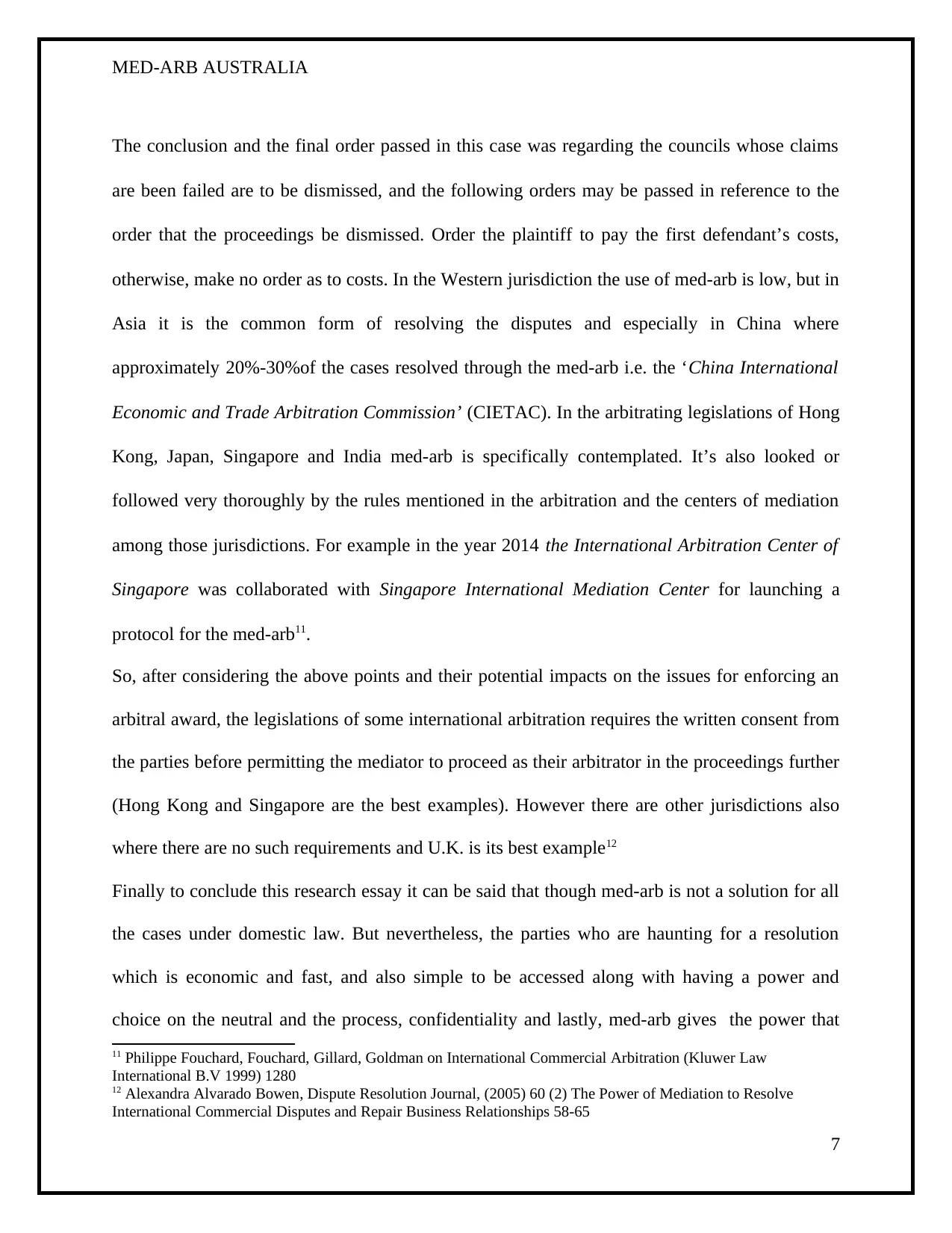
MED-ARB AUSTRALIA
The conclusion and the final order passed in this case was regarding the councils whose claims
are been failed are to be dismissed, and the following orders may be passed in reference to the
order that the proceedings be dismissed. Order the plaintiff to pay the first defendant’s costs,
otherwise, make no order as to costs. In the Western jurisdiction the use of med-arb is low, but in
Asia it is the common form of resolving the disputes and especially in China where
approximately 20%-30%of the cases resolved through the med-arb i.e. the ‘China International
Economic and Trade Arbitration Commission’ (CIETAC). In the arbitrating legislations of Hong
Kong, Japan, Singapore and India med-arb is specifically contemplated. It’s also looked or
followed very thoroughly by the rules mentioned in the arbitration and the centers of mediation
among those jurisdictions. For example in the year 2014 the International Arbitration Center of
Singapore was collaborated with Singapore International Mediation Center for launching a
protocol for the med-arb11.
So, after considering the above points and their potential impacts on the issues for enforcing an
arbitral award, the legislations of some international arbitration requires the written consent from
the parties before permitting the mediator to proceed as their arbitrator in the proceedings further
(Hong Kong and Singapore are the best examples). However there are other jurisdictions also
where there are no such requirements and U.K. is its best example12
Finally to conclude this research essay it can be said that though med-arb is not a solution for all
the cases under domestic law. But nevertheless, the parties who are haunting for a resolution
which is economic and fast, and also simple to be accessed along with having a power and
choice on the neutral and the process, confidentiality and lastly, med-arb gives the power that
11 Philippe Fouchard, Fouchard, Gillard, Goldman on International Commercial Arbitration (Kluwer Law
International B.V 1999) 1280
12 Alexandra Alvarado Bowen, Dispute Resolution Journal, (2005) 60 (2) The Power of Mediation to Resolve
International Commercial Disputes and Repair Business Relationships 58-65
7
The conclusion and the final order passed in this case was regarding the councils whose claims
are been failed are to be dismissed, and the following orders may be passed in reference to the
order that the proceedings be dismissed. Order the plaintiff to pay the first defendant’s costs,
otherwise, make no order as to costs. In the Western jurisdiction the use of med-arb is low, but in
Asia it is the common form of resolving the disputes and especially in China where
approximately 20%-30%of the cases resolved through the med-arb i.e. the ‘China International
Economic and Trade Arbitration Commission’ (CIETAC). In the arbitrating legislations of Hong
Kong, Japan, Singapore and India med-arb is specifically contemplated. It’s also looked or
followed very thoroughly by the rules mentioned in the arbitration and the centers of mediation
among those jurisdictions. For example in the year 2014 the International Arbitration Center of
Singapore was collaborated with Singapore International Mediation Center for launching a
protocol for the med-arb11.
So, after considering the above points and their potential impacts on the issues for enforcing an
arbitral award, the legislations of some international arbitration requires the written consent from
the parties before permitting the mediator to proceed as their arbitrator in the proceedings further
(Hong Kong and Singapore are the best examples). However there are other jurisdictions also
where there are no such requirements and U.K. is its best example12
Finally to conclude this research essay it can be said that though med-arb is not a solution for all
the cases under domestic law. But nevertheless, the parties who are haunting for a resolution
which is economic and fast, and also simple to be accessed along with having a power and
choice on the neutral and the process, confidentiality and lastly, med-arb gives the power that
11 Philippe Fouchard, Fouchard, Gillard, Goldman on International Commercial Arbitration (Kluwer Law
International B.V 1999) 1280
12 Alexandra Alvarado Bowen, Dispute Resolution Journal, (2005) 60 (2) The Power of Mediation to Resolve
International Commercial Disputes and Repair Business Relationships 58-65
7
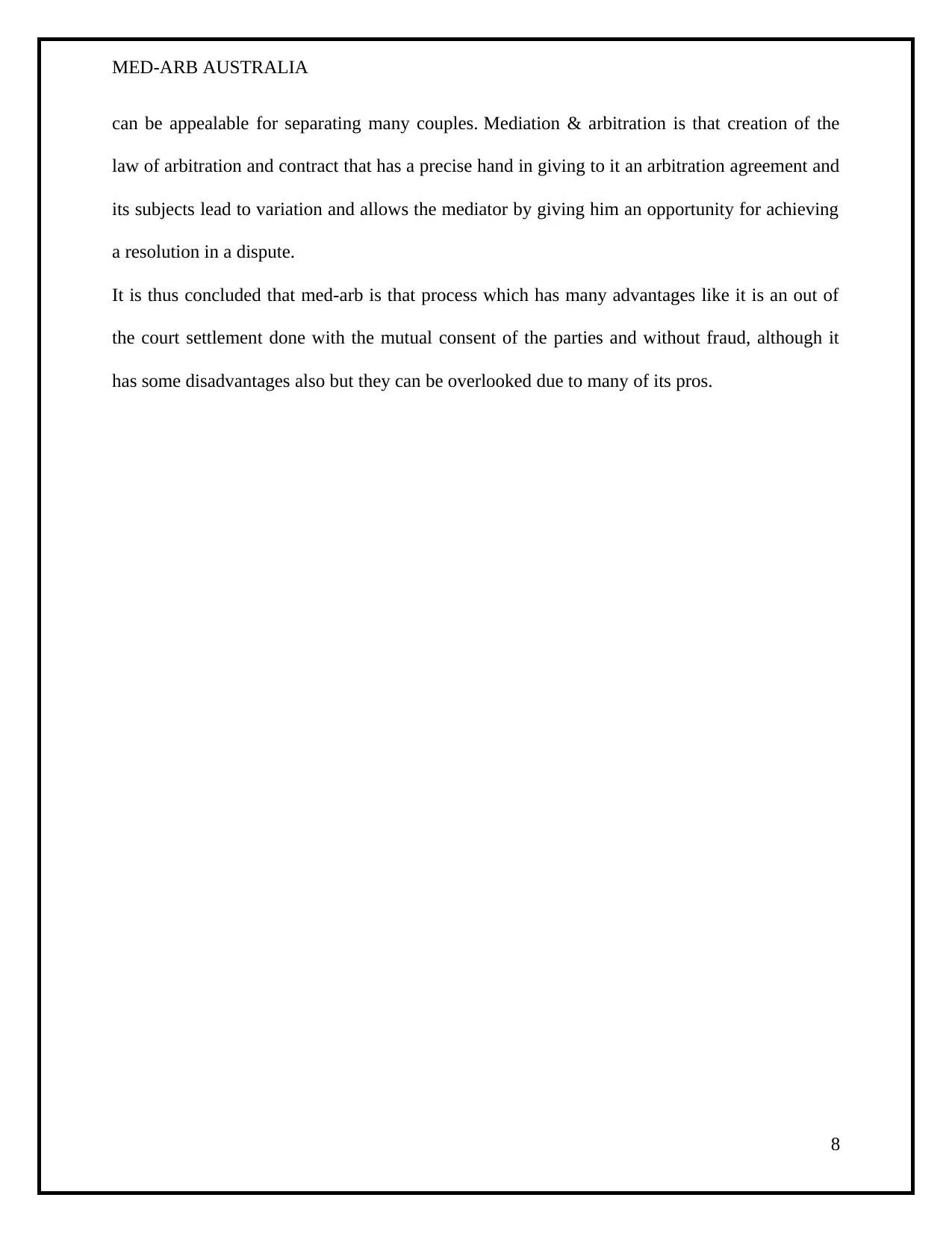
MED-ARB AUSTRALIA
can be appealable for separating many couples. Mediation & arbitration is that creation of the
law of arbitration and contract that has a precise hand in giving to it an arbitration agreement and
its subjects lead to variation and allows the mediator by giving him an opportunity for achieving
a resolution in a dispute.
It is thus concluded that med-arb is that process which has many advantages like it is an out of
the court settlement done with the mutual consent of the parties and without fraud, although it
has some disadvantages also but they can be overlooked due to many of its pros.
8
can be appealable for separating many couples. Mediation & arbitration is that creation of the
law of arbitration and contract that has a precise hand in giving to it an arbitration agreement and
its subjects lead to variation and allows the mediator by giving him an opportunity for achieving
a resolution in a dispute.
It is thus concluded that med-arb is that process which has many advantages like it is an out of
the court settlement done with the mutual consent of the parties and without fraud, although it
has some disadvantages also but they can be overlooked due to many of its pros.
8
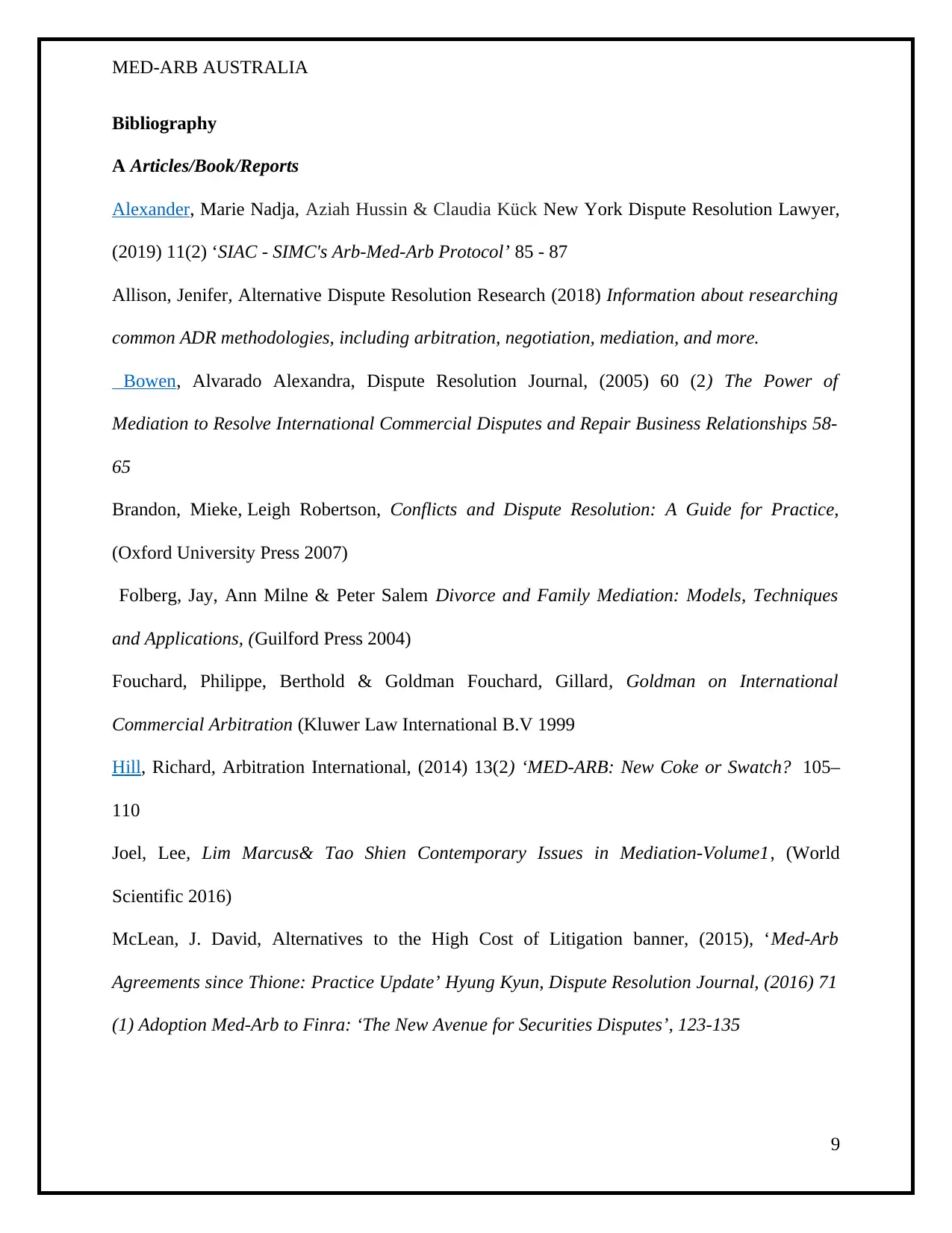
MED-ARB AUSTRALIA
Bibliography
A Articles/Book/Reports
Alexander, Marie Nadja, Aziah Hussin & Claudia Kück New York Dispute Resolution Lawyer,
(2019) 11(2) ‘SIAC - SIMC's Arb-Med-Arb Protocol’ 85 - 87
Allison, Jenifer, Alternative Dispute Resolution Research (2018) Information about researching
common ADR methodologies, including arbitration, negotiation, mediation, and more.
Bowen, Alvarado Alexandra, Dispute Resolution Journal, (2005) 60 (2) The Power of
Mediation to Resolve International Commercial Disputes and Repair Business Relationships 58-
65
Brandon, Mieke, Leigh Robertson, Conflicts and Dispute Resolution: A Guide for Practice,
(Oxford University Press 2007)
Folberg, Jay, Ann Milne & Peter Salem Divorce and Family Mediation: Models, Techniques
and Applications, (Guilford Press 2004)
Fouchard, Philippe, Berthold & Goldman Fouchard, Gillard, Goldman on International
Commercial Arbitration (Kluwer Law International B.V 1999
Hill, Richard, Arbitration International, (2014) 13(2) ‘MED-ARB: New Coke or Swatch? 105–
110
Joel, Lee, Lim Marcus& Tao Shien Contemporary Issues in Mediation-Volume1, (World
Scientific 2016)
McLean, J. David, Alternatives to the High Cost of Litigation banner, (2015), ‘Med-Arb
Agreements since Thione: Practice Update’ Hyung Kyun, Dispute Resolution Journal, (2016) 71
(1) Adoption Med-Arb to Finra: ‘The New Avenue for Securities Disputes’, 123-135
9
Bibliography
A Articles/Book/Reports
Alexander, Marie Nadja, Aziah Hussin & Claudia Kück New York Dispute Resolution Lawyer,
(2019) 11(2) ‘SIAC - SIMC's Arb-Med-Arb Protocol’ 85 - 87
Allison, Jenifer, Alternative Dispute Resolution Research (2018) Information about researching
common ADR methodologies, including arbitration, negotiation, mediation, and more.
Bowen, Alvarado Alexandra, Dispute Resolution Journal, (2005) 60 (2) The Power of
Mediation to Resolve International Commercial Disputes and Repair Business Relationships 58-
65
Brandon, Mieke, Leigh Robertson, Conflicts and Dispute Resolution: A Guide for Practice,
(Oxford University Press 2007)
Folberg, Jay, Ann Milne & Peter Salem Divorce and Family Mediation: Models, Techniques
and Applications, (Guilford Press 2004)
Fouchard, Philippe, Berthold & Goldman Fouchard, Gillard, Goldman on International
Commercial Arbitration (Kluwer Law International B.V 1999
Hill, Richard, Arbitration International, (2014) 13(2) ‘MED-ARB: New Coke or Swatch? 105–
110
Joel, Lee, Lim Marcus& Tao Shien Contemporary Issues in Mediation-Volume1, (World
Scientific 2016)
McLean, J. David, Alternatives to the High Cost of Litigation banner, (2015), ‘Med-Arb
Agreements since Thione: Practice Update’ Hyung Kyun, Dispute Resolution Journal, (2016) 71
(1) Adoption Med-Arb to Finra: ‘The New Avenue for Securities Disputes’, 123-135
9
Secure Best Marks with AI Grader
Need help grading? Try our AI Grader for instant feedback on your assignments.

MED-ARB AUSTRALIA
Nigmatullina, Dilyara, Combining Mediation and Arbitration in International Commercial
Dispute Resolution, (Rutledge 2018)
B Cases
Ku-ring-gai Council v Ichor Constructions Pty Ltd [2018] NSWSC 610
10
Nigmatullina, Dilyara, Combining Mediation and Arbitration in International Commercial
Dispute Resolution, (Rutledge 2018)
B Cases
Ku-ring-gai Council v Ichor Constructions Pty Ltd [2018] NSWSC 610
10
1 out of 11
Related Documents
Your All-in-One AI-Powered Toolkit for Academic Success.
+13062052269
info@desklib.com
Available 24*7 on WhatsApp / Email
![[object Object]](/_next/static/media/star-bottom.7253800d.svg)
Unlock your academic potential
© 2024 | Zucol Services PVT LTD | All rights reserved.





